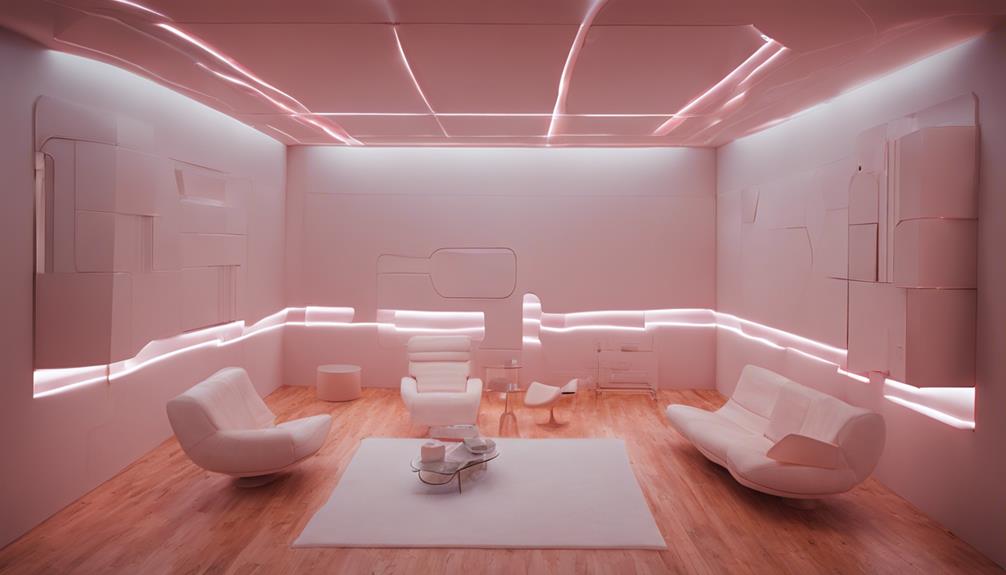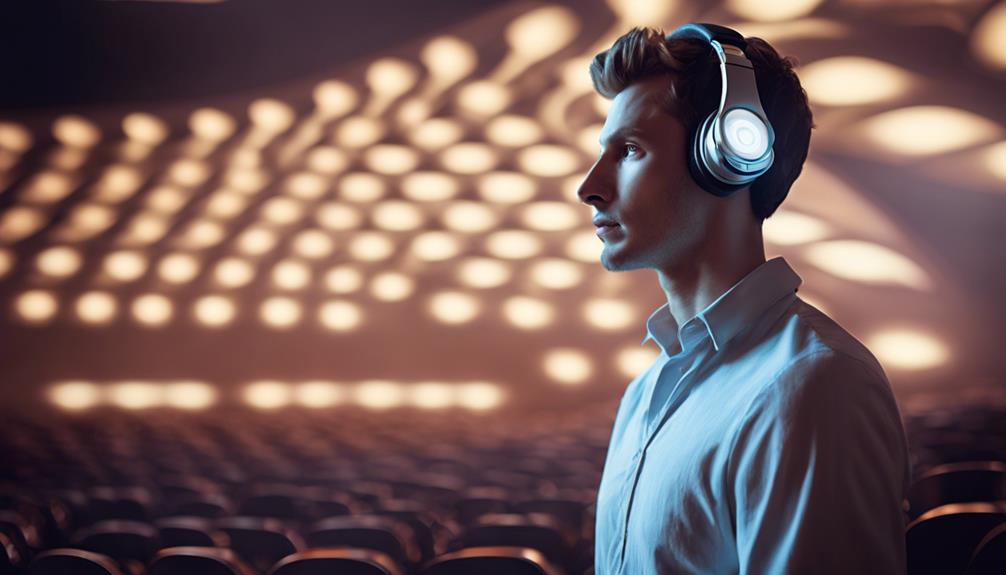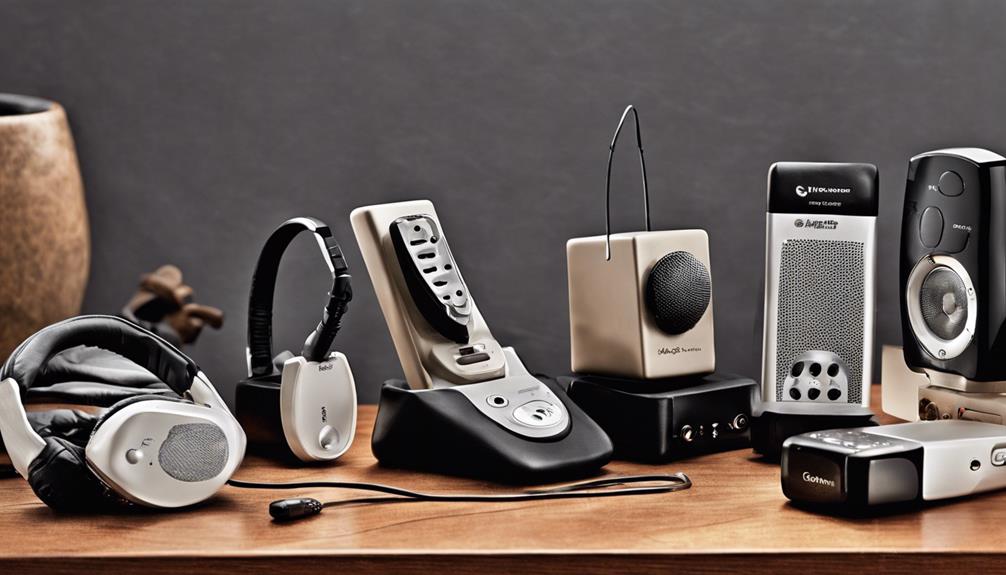Curious about the hidden world of infrared assistive listening devices? These innovative tools offer discreet assistance for individuals with hearing impairments.
But how exactly do they work their magic? Let's unravel the mystery behind these devices and shed light on their inner workings, shedding a new perspective on enhancing auditory experiences.
Key Takeaways
- Infrared assistive listening devices use light waves for wireless audio transmission.
- Components include radiators, audio sources, and wireless receivers.
- Ideal for venues requiring privacy and sound isolation.
- Ensures clear sound delivery with minimal interference for enhanced communication.
Overview of Infrared Listening Devices
In exploring Infrared Listening Devices, it's essential to understand how they utilize light waves to transmit audio signals to users. Infrared systems for assistive listening rely on infrared radiation to deliver sound directly to wireless receivers worn by individuals. These devices are particularly useful in environments like theaters and council chambers where precise hearing support is crucial. By emitting invisible infrared light, these systems ensure privacy and prevent sound overspill into adjacent areas, making them ideal for situations requiring confidentiality.
Infrared listening devices typically consist of infrared radiators, audio sources, and wireless receivers. The radiators transmit modulated infrared signals carrying audio information, which are then picked up by the receivers worn by individuals seeking assistance with hearing. The receivers convert the light signals back into sound, allowing users to listen to the audio content without disturbances. This technology offers a reliable and efficient way to provide assistive listening solutions in various settings, ensuring clarity and accessibility for individuals with hearing impairments.
Infrared Technology Explained

Exploring the intricacies of Infrared Technology, we delve into how this innovative system harnesses invisible infrared light to efficiently transmit audio signals to wireless receivers.
- Infrared assistive listening devices operate using infrared light, which is invisible to the human eye but carries audio signals effectively.
- These systems are composed of audio sources, infrared radiators, and listening receivers that convert the infrared light signals back into audio for the user.
- Infrared technology offers the advantage of preventing overspill into adjacent rooms, making it ideal for situations where privacy is crucial.
- The modulator within the system processes the audio signal before it's sent to the radiator, which then emits infrared light for conversion by the wireless receivers.
Infrared systems play a vital role in various settings such as theatres for hearing support and council chambers for interpreter services, meeting the stereo sound requirements outlined in the Equality Act.
Transmission of Sound Signals
Utilizing the invisible medium of infrared light, the transmission of sound signals in infrared assistive listening devices is facilitated efficiently and securely.
Infrared assistive listening devices operate by employing light waves in the infrared spectrum to transmit sound signals wirelessly. These systems typically consist of an audio source, an infrared radiator, and listening receivers.
The audio source feeds the signal to the infrared radiator, which then converts the signal into infrared light waves. These light waves carry the audio information to the wireless receivers worn by the users.
The receivers receive the infrared signal and convert it back into sound, allowing the user to hear the transmitted audio clearly. Infrared systems are particularly suitable for environments where privacy and reduced interference are essential, such as theaters, council chambers, and other public venues.
Wireless Amplification Features

Let's explore the wireless amplification features of infrared assistive listening devices.
These devices utilize infrared light to transmit signals wirelessly, ensuring efficient sound amplification.
Focusing on signal transmission methods, range, and coverage is crucial for optimizing audio delivery in various settings.
Signal Transmission Methods
Infrared assistive listening devices employ wireless transmission of audio signals using invisible infrared light, converting sound signals into light waves for transmission to specialized receivers. When discussing signal transmission methods, it's crucial to understand the intricacies of how these devices work.
- Invisible Transmission: Infrared systems use light waves that are unseen to the naked eye, ensuring privacy and reducing distractions.
- Secure Communication: The use of infrared light for signal transmission minimizes the risk of signal interception or interference from external sources.
- Focused Signal Delivery: Infrared signals can be directed precisely to the intended receivers, reducing the likelihood of signal leakage to unwanted areas.
- Efficient Signal Conversion: Receivers efficiently convert the light signals back into clear audio, ensuring high-fidelity sound reproduction for users.
Range and Coverage
When considering the wireless amplification features of infrared assistive listening devices, it's essential to understand the range and coverage capabilities they offer.
Infrared technology enables these devices to transmit wireless signals up to 100 feet, providing wide room coverage for clear audio reception throughout the designated area. The use of infrared technology also helps prevent signal interference and crosstalk, ensuring reliable communication.
Users can freely move within the coverage area without experiencing disruptions in the connection to the audio source. These features make infrared assistive listening devices ideal for venues where secure and private listening experiences are crucial, such as courtrooms or conference rooms.
Applications in Various Settings

Infrared assistive listening devices offer versatile applications in diverse settings, catering to the specific needs of users in various environments.
From theaters requiring audio description to council chambers with interpreter needs, these systems prove beneficial.
Their ease of installation and ability to maintain signal integrity make them a practical choice for multi-level rooms and portable setups.
Settings for Applications
Within various public venues such as theaters, council chambers, and auditoriums, the applications of infrared assistive listening devices play a crucial role in providing essential hearing support and enhancing communication accessibility. These devices are versatile and can be utilized in a range of settings, including:
- Theaters: Infrared systems in theaters enable patrons to enjoy clear audio, language interpretation, and enhanced sound quality for an immersive experience.
- Council Chambers: These systems facilitate seamless communication during meetings by offering language interpretation services and ensuring every participant can effectively hear and engage.
- Auditoriums: In auditorium settings, the signal strength of infrared devices ensures consistent audio delivery, making them ideal for lectures, presentations, and performances.
- Public Venues: Compliance with accessibility regulations like the Equality Act ensures that public venues are inclusive and accommodating to individuals with hearing impairments.
Diversity in Environments
Utilizing infrared assistive listening devices across diverse environments enhances communication accessibility and ensures effective hearing support in a variety of settings.
Infrared systems are commonly employed in theaters to provide hearing assistance and audio description services. Additionally, they play a crucial role in council chambers by facilitating interpreter services and floor language communication.
These systems comply with the Equality Act and are well-suited for stereo sound applications. Their ability to prevent overspill into adjacent rooms makes them ideal for a range of settings.
In environments with multiple levels and without loop wire infrastructure, infrared systems offer a more straightforward installation process compared to induction loop systems. This adaptability and ease of installation make infrared assistive listening devices a versatile solution for enhancing communication accessibility in diverse environments.
Enhanced Communication for Hearing Impaired

When seeking to enhance communication for individuals with hearing impairments, the use of infrared assistive listening devices can significantly improve audio reception without disrupting surrounding environments. Infrared systems offer a reliable solution for those in need of enhanced communication, especially in settings like theaters, classrooms, and public venues. Here are four key features of how these devices enhance communication for the hearing impaired:
- Infrared Transmission: Utilizing infrared light, these devices transmit audio signals to receivers worn by the users, ensuring clear and direct sound delivery.
- Emitter Technology: Emitters within the system convert sound into light waves, which are then picked up by the receivers for conversion back into audible sound.
- Portable and Versatile: Infrared devices are easily portable, allowing individuals to carry them to different environments and enabling enhanced communication wherever they go.
- Minimal Signal Interference: By preventing signal spillage, these devices maintain privacy and prevent audio crossover, ensuring a focused listening experience for the user.
Mechanics Behind Infrared Devices

To understand the mechanics behind infrared assistive listening devices, it's essential to grasp how these systems function in transmitting audio signals effectively to users with hearing impairments. Infrared devices operate by utilizing infrared light to transmit audio signals from an audio source to listening receivers.
The core components of these devices include the audio source, an infrared radiator, and the receivers. The infrared radiator emits infrared light, which is invisible to the naked eye but serves as the carrier for audio signals. The receivers then capture this infrared light and convert it back into audio signals that can be heard by the users.
One of the key advantages of using infrared systems is their ability to provide secure transmission of sound within a specific area, making them ideal for environments where radio frequency interference is a concern. Additionally, these devices prevent spillover of sound into adjacent spaces, ensuring a more focused listening experience for individuals with hearing impairments.
Transformation of Hearing Experience

The evolution of infrared assistive listening devices revolutionizes the way individuals with hearing impairments perceive and engage with audio content.
- Conversion Process: Infrared assistive listening devices transform audio signals into invisible infrared light waves for transmission, ensuring a seamless communication channel for users.
- Components Interaction: These devices comprise audio sources, infrared radiators, and listening receivers that collaboratively work to deliver clear sound to individuals challenged by hearing impairments.
- Wireless Transmission: Invisible infrared light emitted by the infrared radiators is captured and converted back into audio signals by the wireless receivers worn by the users, enabling a wireless and efficient transmission process.
- Advantages Over Traditional Systems: Infrared systems offer advantages over induction loop systems by preventing overspill into adjacent rooms, simplifying installation in multi-level spaces without loop wires, and finding diverse applications in various settings like theaters and council chambers for compliance with accessibility regulations.
Frequently Asked Questions
How Does an Assistive Listening Device Work?
When we consider how an assistive listening device works, it's crucial to understand the technology behind it. These devices function by capturing and amplifying sound, making it clearer and louder for the user.
What Are the Four Major Types of Assistive Listening Devices?
When considering the four major types of assistive listening devices, we find a range of options catering to diverse needs. These include:
- Infrared systems
- FM systems
- Loop systems
- Bluetooth systems
Each type offers unique advantages in terms of signal clarity, coverage range, and compatibility with various hearing aids.
Understanding the distinctions among these four types is crucial for selecting the most suitable assistive listening device for specific environments and users.
How Does an FM System Work?
FM systems work by transmitting sound directly from a microphone to a receiver. This technology is beneficial in various settings like classrooms, theaters, and restaurants where improved hearing is needed.
FM systems help overcome challenges such as distance, noise, and echoes by delivering the speaker's voice clearly to the listener. They can be used with or without hearing aids or cochlear implants, providing enhanced hearing experiences for individuals in different environments.
How Do Listening Devices Work?
We love diving into the inner workings of listening devices!
They harness advanced technology to transmit audio signals wirelessly, enhancing accessibility.
These devices ingeniously convert audio into light signals for transmission, allowing users to enjoy clear sound through specialized receivers.
The intricate process ensures a seamless audio experience, making these devices indispensable in various settings.
Their efficiency and reliability truly elevate the listening experience for all users.
Conclusion
In conclusion, while some may question the effectiveness of infrared assistive listening devices, their discreet transmission of audio signals through light waves offers a unique solution for individuals with hearing impairments.
By providing wireless amplification and enhancing communication in various settings, these devices revolutionize the hearing experience.
Embrace the advanced technology of infrared systems to improve your listening capabilities without disturbing others, and discover a whole new world of sound clarity and accessibility.











